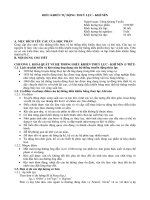Thuyết trình thủy lực khí nén
Bạn đang xem bản rút gọn của tài liệu. Xem và tải ngay bản đầy đủ của tài liệu tại đây (598.48 KB, 31 trang )
Pneumatic & Hydraulic Technology
Pneumatic Valves
CONTENTS
1. Introduction
2. Directional control valves
3. Non-return valves
4. Flow control valves
5. Pressure control valves
6. Shut-off valves
7. Combinational valves
1)Introduction
The range of pneumatic valves is vast.
To help select a valve they are placed in a variety of categories:
●
●
●
●
●
●
●
Style
Type
Design principle
Type of operator
Function
Size
Application
1)Introduction
●
For all of them, their basic function is to switch air flow
●
From the simplest function of switching a single flow path On and Off, to the exacting
proportional control of pressure and flow
2 ) Directional control valves
●
Categorised
○
Poppet valves
■
■
○
Ball seat valve
Disc seat valve
Slide valves
■
■
■
longitudinal slide valve
longitudinal flat slide valve
plate slide valve
2 ) Directional control valves
➔
Type of valves
●
2/2 - way valve
●
3/2 - way directional control valve
●
4/2 - way directional control valve
●
5/2 - way directional control valve
●
Seals in spool valves
2/2 - way direction valve
●
2 ports 2 positions
●
sign:
3/2-WAY DIRECTIONAL VALVE
●
3/2 - Roller lever valve, internal pilot, normally closed
●
3/2 - way directional valve With air pressure pilot operation
●
3/2 - way directional valve Normally closed
●
3/2 - way directional valve Normally closed with disc seat principle (poppet valve)
●
3/2 - way directional valve Normally open
●
3/2 - way directional valve Seat valve, with air pilot operation
●
3/2 - way directional valve Spool valve
●
3/2 - way directional valve Hand slide valve
4/2 - way directional control valve
●
4/2 - way directional control valve, air pilot actuated
●
4/2 - way directional control valve, slide valve
●
4/2 - way directional control valve with roller lever and internal pilot valve
●
4/2 - way valve, disc seat
●
4/3 - way directional control valve, rotary slide valve
5/2 - way directional control valve
●
5/2 - way directional control valve, spool valve, compressed air actuated
5/2-way directional control valve, spool valve, compressed air
actuated
●
Sign:
●
In slide valves the control member moves transverse to the direction of flow of the medium to
be controlled.
Seals in spool valves
●
sealing between the spool and the valve body is achieved by precise trueing.
●
To reduce the danger of damage to sealing elements through shearing at the inside connecting
port
3) Non-return valves
TYPE:
●
Non-return valve (check value)
●
Shuttle valve (Logic: OR)
●
Two-pressure valve (Logic: AND)
●
Rapid exhaust valve
Non-return valves
●
Sign:
●
Permit flow of air in one direction only and shut off the opposite direction.
Shuttle value
●
Sign:
●
Permits compressed air to flow from either of the connections X (P1) and Y (P2) to the ball in
the valve always shuts off the opposite connection.
Two-pressure valve
●
Sign:
●
If one of the input signals is delayed it flows to port A. Pressure gradient results in the lower
pressure
Rapid exhaust valve
●
Sign:
●
Uses for fast ventilation of cylinders and pipes
4) Flow Control Valves
1.
Throttle Valves , Bi-directional
2.
Flow control - check valves
Throttle Valves , Bi-directional
-The throttle valve is a flow control valve.
-Flow control valves influence the volumetric flow of the compressed air in both directions
-Using for speed control of cylinders
Flow control - check valves
-In non-return valves (one direction valve) compressed air can only flow in one direction through a port which can be set by a screw
-The adjustable port permits flow control from 0 up to the nominal width of the valve
-These valves are used for speed regulation of actuators and if possible, should be mounted directly on the cylinder
5) Pressure Control Valves
Pressure control valves are elements which predominantly influence the pressure or are
controlled by the magnitude of the pressure.
1.
Pressure Sequence Valve
2.
Pressure Regulator With Relief Port
Pressure Sequence Valve
-It is installed in pneumatic controls where a specific
pressure is required for switching operation
-If the pressure exceeds that set on the spring, the valve
opens.
-The flow from 1 to 2 is closed. Outlet 2 is opened only if a
preset pressure has built up in pilot line 12. A pilot spool
opens the passage 1 to 2
Pressure Regulator With Relief Port
-Reduce high input pressure to a low output pressure.
-They prevent the maximum permissible pressure in a system from being exceeded
-The output pressure is adjustable and is nearly kept constant
It provides compensation of overload in system, using mainly as safety valves
-The set screw permits adjustment of the initial tension in the spring.
6) Shut-off valves
Shut-off valves, cocks
Safety and Effectiveness in industry
Shut-off valves, cocks
●
Shut off valves are used for shutting off pneumatic devices or pneumatic
circuits.
●
Air may flow in both directions.









